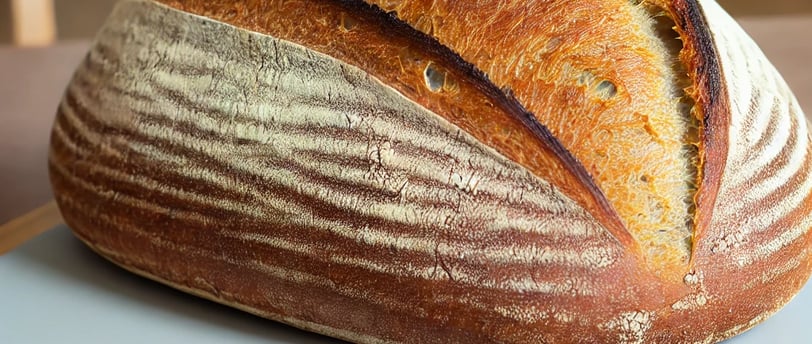Bake Your Own Bread: The Holy Roller Classic Rustic Loaf
Discover step-by-step instructions for baking a rustic loaf using a sourdough starter. Perfect your rustic loaf with our Holy Roller Classic recipe.
9/27/20243 min read


If you've ever dreamed of filling your home with the irresistible aroma of freshly baked bread, then it's time to roll up your sleeves and bake your own bread. Today, we're diving into the world of sourdough with a recipe that's perfect for both beginners and seasoned bakers alike: the Holy Roller Classic Rustic Loaf.
This rustic loaf combines the tangy flavor of a sourdough starter with the hearty texture of a traditional artisan bread. Whether you're making sandwiches or simply enjoying a slice with butter, this rustic loaf will quickly become a household favorite.
Ingredients
115 g (3/4 cup) sourdough starter
310 g (1 1/4 cups) filtered water
250 g (2 cups) bread flour
250 g (2 cups) all-purpose flour
10 g (2 teaspoons) salt
Instructions
Activate Your Sourdough Starter
The night before your bake day, feed your sourdough starter to activate it. This step can also be done in the morning if you prefer to mix in the evening and allow your dough to proof overnight. The timing can be adjusted based on your schedule and experience, but ensure your starter is active and bubbly before you begin.
Mix the Dough
Combine Starter and Water: In a medium mixing bowl, mix the active sourdough starter and filtered water until it appears milky.
Add Flours: Measure out both the bread flour and all-purpose flour. Gradually add them to the bowl, stirring with a spoon or whisk until the mixture becomes sticky.
Incorporate Salt: Add the salt and mix well. Use your hands to form the dough into a shaggy ball.
Rest: Cover the bowl and let the dough rest for 1 hour. This rest period allows the flour to fully hydrate.
Stretch and Fold
After the initial rest, it's time to develop the dough's gluten structure through a series of stretch and folds.
First Stretch and Fold: With wet hands, lift one side of the dough, stretch it upward, and fold it over to the opposite side. Rotate the bowl a quarter turn and repeat until you've completed four folds.
Repeat: Perform this stretch and fold technique every 30 minutes for a total of 4-6 sets. You'll notice the dough becoming smoother and more elastic with each set.
Bulk Fermentation
After the final stretch and fold, cover the dough and let it rest for its bulk ferment. The dough should double in size, which can take up to 12 hours depending on the strength of your starter and the temperature of your kitchen.
Shape the Loaf
Prepare the Surface: Lightly flour your work surface and gently pour out the dough.
Shape: Tuck the edges of the dough underneath itself, rotating and pulling it towards you to create surface tension. Form it into a tight, smooth ball without tearing the dough.
Second Fermentation: Place the shaped dough into a towel-lined basket or bowl. Cover it and let it rest for 2-3 hours.
Baking the Bread
Preheat the Oven: Place your Dutch oven with its lid inside your oven and preheat to 450°F (232°C).
Score the Loaf: Transfer the loaf onto a piece of parchment paper. Using a bread lame, razor blade, or sharp knife, make a long slash across the top. This score allows steam to escape and helps the loaf expand.
Bake: Carefully place the loaf (with parchment paper) into the preheated Dutch oven. Reduce the oven temperature to 425°F (218°C) and bake covered for 25 minutes.
Finish Baking: Remove the lid and continue baking for another 20-25 minutes, or until the loaf is a rich golden brown.
Cool: Remove the bread from the Dutch oven and let it cool on a wire rack for at least 1 hour before slicing.
Optional: Cold Proofing
If you prefer to bake your loaf at a later time, you can opt for a cold proof:
After shaping, place the dough in a proofing basket or bowl and cover tightly with plastic wrap.
Refrigerate for a minimum of 5 hours, up to 2 days.
When ready to bake, let the dough sit at room temperature for about an hour, then score and bake as directed.
Enjoy Your Homemade Rustic Loaf
There's nothing quite like the satisfaction of slicing into a loaf of bread that you've made with your own hands. This Holy Roller Classic Rustic Loaf not only makes for an excellent sourdough sandwich bread but also stands on its own with a pat of butter or a drizzle of olive oil.
By mastering this recipe, you're embracing the timeless tradition of bread baking and the unique nuances of working with a sourdough starter. Happy baking!


